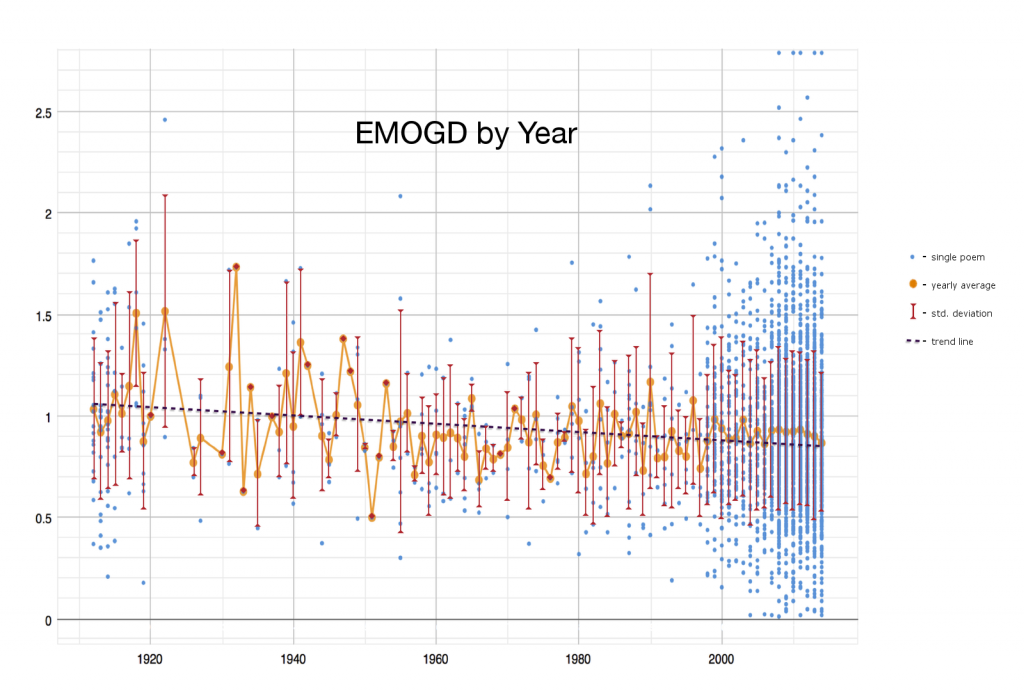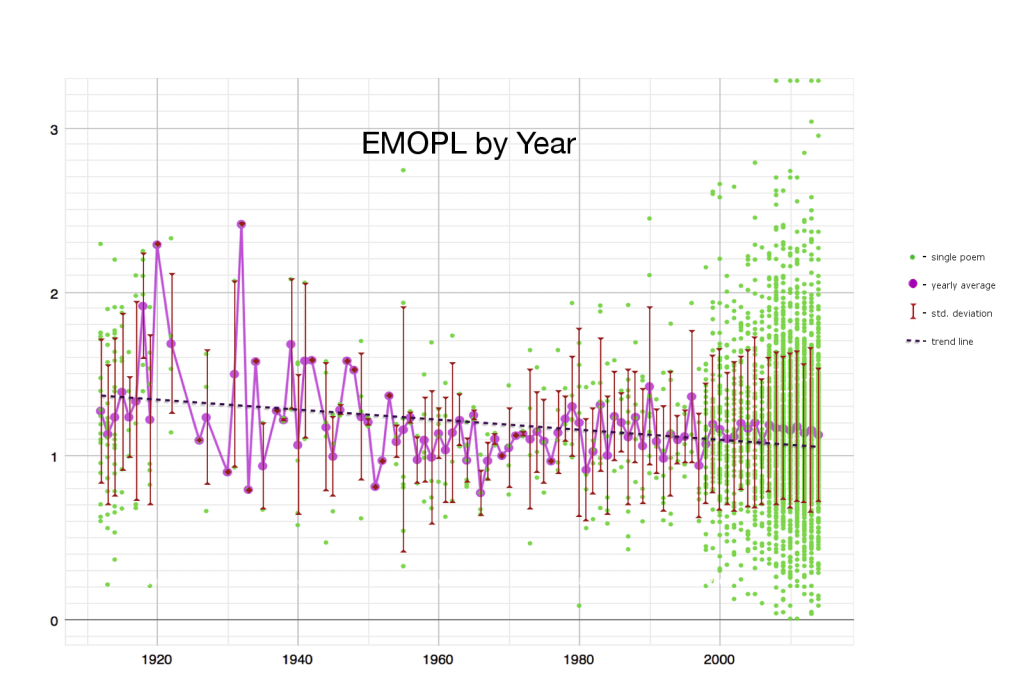“You do not have to be good.”
-Mary Oliver, “Wild Geese”
What kind of poetry will people be reading 100 years from now? It is impossible to predict for sure. Yet certain quantifiable trends in the poems published over the past hundred years give a definite indication of where poetry has been, and may give us some clues as to where it is going.
Methodology
As I have said before, aesthetic matters must be confronted on aesthetic terms. In 1968 a team of researchers asked people to rate different words in the English language on various numerical scales, such as the age the person first learned the meaning of this word and whether the word denotes something masculine or feminine. In 2004, another team extended this research, giving us the Clark and Paivio (2004) Norms–a set of 32 different scores for 925 special words (hereafter “Clark-Paivio words”).
Poetry magazine may be considered a bellwether of taste in American poetry, and conveniently has made nearly 3,000 poems stretching from its inception in 1912 to the present day all available online.
I trained computer software to analyse each one of these poems, counting how often a Clark-Paivio word appeared, which happened nearly 23,000 times in the available online corpus of poems. Armed with this large collection data, I then used a strategy similar to that of Michael Coleman Dalvean, creator of Poetry Assessor. I took the averages of the Clark-Paivio word scores across all 32 variables, rolling these up into an overall score for each poem. For example, the Clark-Paivio word with the lowest age of acquisition is “toy” at 1.5, whereas “bivouac” gets a score of 6.7. If a poem used both words, the poem itself would then get a score of (1.5 + 6.7) / 2 = 4.1 for the “age” variable.
I then went a step further, calculating average scores for each calendar year by averaging across all the poems in that year. Swimming through all this data, I then began to apply trendlines to graphs of variables by year. What I discovered is that two variables in particular — the rating of words that connote emotional goodness, and a kind of sister variable, the rating of words that connote emotional pleasantness — have been on a consistent downward trend since 1912.
Results
Here are visualisations of the data on emotional goodness and emotional pleasantness. To give the flavour of each score, I have included a poem that most closely matches the score, and a single word from the Clark-Paivio words as well.
Trends in Use of Words Connoting Emotional Goodness in Poetry
| Score | Representative Poem | Representative Word | |
| Trend Top (1912) | 1.1 | “Poetry” by Arthur Davidson Ficke, 1912 | Unification |
| Trend Bottom (2014) | 0.8 | “Much Better Than a Goat” by Gerald Stern, 2014 | Aberration |
| Trend Extrapolation (2116) | 0.5 | “Sea Sickness” by Ilya Kutik, 2014 | Hierarchy |
Trends in Use of Words Connoting Emotional Pleasantness in Poetry
| Score | Representative Poem | Representative Word | |
| Trend Top (1912) | 1.3 | “Under Two Windows” by Schuyler Van Rensselaer, 1912 | Welfare |
| Trend Bottom (2014) | 1.0 | “I Wanted to Make Myself like the Ravine” by Hannah Gamble, 2014 | Proprietor |
| Trend Extrapolation (2116) | 0.7 | “How to Draw a Perfect Circle” by Terrance Hayes, 2014 | Sultan |
Interpretation and Conclusions
Clearly, a poem like “Poetry” by Arthur Davidson Ficke, published in 1912 has a very different feel than Gerald Stern’s “Much Better Than a Goat”, published in 2014. Yet each is a centre point of “emotional goodness” for its era. Likewise, the translation of Ilya Kutik’s “Sea Sickness” is different again from Stern’s poem. If this trend continues, a poem like it may well become the centre point of “emotional goodness” 100 years from now. The results for “pleasantness” are strikingly similar.
Poetry is a rich and varied art. In fact, the measured emotional range of individual poems as visualised on the charts above is massive. For this reason, as human readers of poetry, we spot the differences. Yet large-scale numerical analysis points up that there is a centre point of taste in American poetry when it comes to positive emotions, and this centre point has been drifting downward throughout the twentieth century, and into our present time.
For all of the theories about what postmodernism and post-war disillusionment looks like in modern literature, the sloping trend lines in the above two graphs give one of the clearest pictures I have seen.

